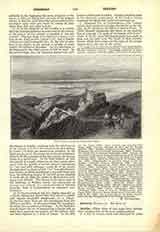

Jericho.—Three cities of this name have successively occupied sites in the same neighborhood.
I. A city of Canaan taken and destroyed by Josue after the passage of the Jordan (Jos., vi). The establishment of the Israelites in the industries of the “City of Palm Trees” gave birth to the Jericho of Benjamin (Jos., xviii, 21), which was for some time dominated by Eglon, King of Moab (Judges, iii, 12), and in which David’s emissaries hid themselves when they had been outraged by Hanon, King of the Ammonites (II Kings, x, 5). But when, under Achab, the Canaanite Jericho had been restored by Hiel the Bethelite (III Kings, xvi, 34), the Israelites installed themselves there. They were visited by Eliseus, who purified the waters of the spring (IV Kings, ii, 18-22). Three hundred and forty-five men of Jericho, returning from captivity, repopulated their native city (I Esd., ii, 34; II Esd., vii, 36). Having fallen into the hands of the Syrians, it was fortified by Bacchides, to protect Judea on the eastern side (I Mach., ix, 50). This Jericho was situated at Tell-es-Sultan, near the Fountain of Eliseus (Ain-es-Sultan), which flows at a distance of about two miles northwest of ez-Riba, the modern Jericho. Excavations made in this tell in 1907-08 brought to light a rampart measuring some 840 yards in circuit, a citadel with double wall of the Canaanite period, Israelitish dwellings of the time of the Kings, and some post-exilic Jewish pottery (Mitteil. der deutschen Orient. Gesellschaft zu Berlin, December, 1908, no. 39; “Revue Biblique”, 1909, 270-79).
The ancient Jericho, near the spring, had entirely disappeared when Herod founded a new Jericho towards the point where the brook of the Kett and the Jerusalem road emerge from the mountains. Protected by the fort of Cypros, it possessed royal palaces, vast reservoirs, a hippodrome, and an amphitheatre (Josephus, “Bell. Jud.”, I, xxi, 14; xxxiii, 6, 8; “Antiq. Jud.”, XVI, v, 2). Herod died there: his son Archelaus further embellished the palaces and caused new aqueducts to be built to bring water to the palm gardens (Antiq. Jud., XVII, xiii, 1). It was at the gates of this Jericho that Christ cured two blind men (Matt., xx, 29-34), only one—Bartimeus—according to Mark (x, 46) and Luke (xviii, 35), and saw the publican Zacheus (Luke, xix, 1-5). The Khirbet Qagfin, the Birket Musa, a few artificial mounds, are the visible remains of the second Jericho, which, before being entirely destroyed, served for some days as a Roman camp (Bell. Jud., viii, 2; ix, 13).
A third Jericho then came into existence in the gardens which the Fountain of Eliseus watered, and where, besides the palm, grew the henna, balm, myrrh (Bell. Jud., IV, viii, 3), the sycamore, banana, etc. According to the map of the Madaba, it was an important city and a see suffragan to Caesarea Maritima. Its known bishops are Januarius (325), Macer (381), Eleutherius (415), Joannes (518), Gregorius (536), Basilius (800) (Lequien, “Oriens Christianus”, III, 646-50). Justinian set up here a great caravanserai (Procopius, “De Aedif.”, v, 9). During the Crusades Jericho was a benefice attached to the Holy Sepulcher. The Byzantine city was succeeded by the present Rita, which consists of a few hostelries for pilgrims and tourists, and some fifteen wattle huts inhabited by Ghawarneh Arabs. There is also a Greek church (called “the Sanctuary of Zacheus”) served by two Orthodox monks, a Latin chapel, and a mosque.
F. M. ABEL

